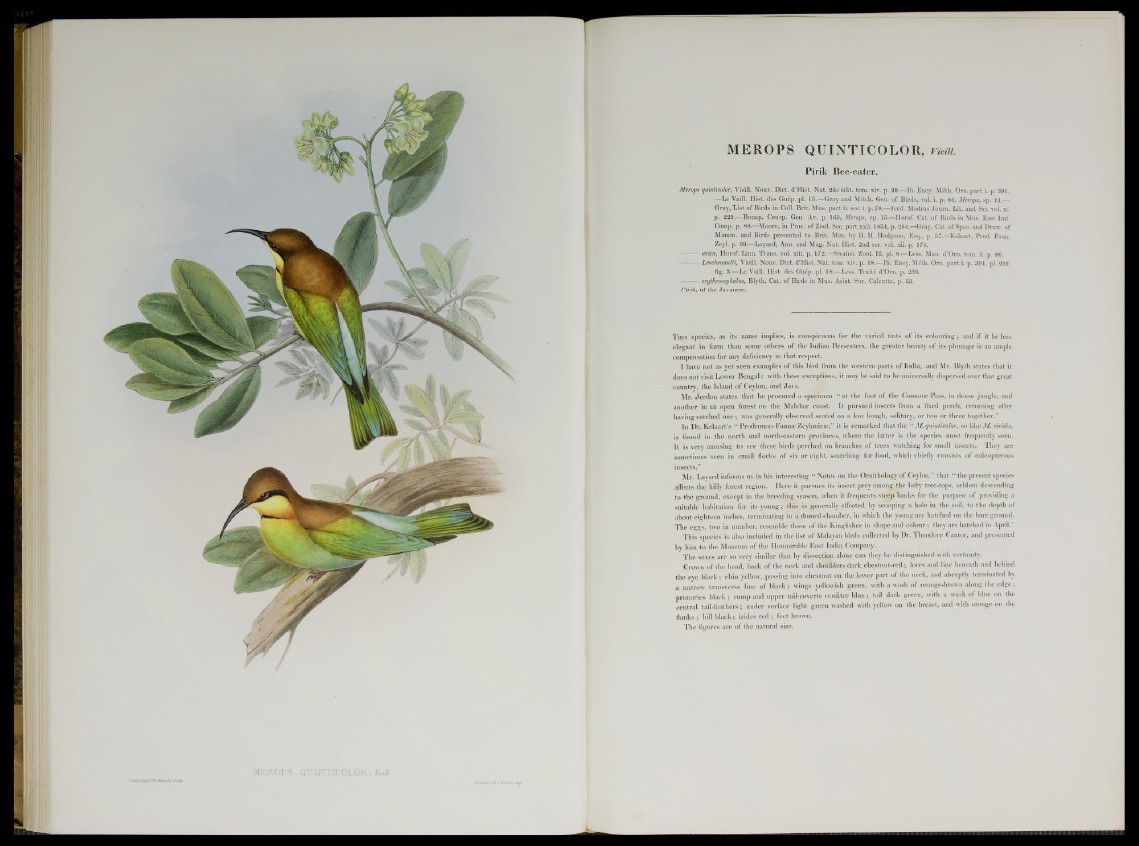
MEROPS QUINTICOLOR, vidii.
P irik Bee-eater.
Merops quinticolor, Yieill. Nouv. Diet. d’Hist. Nat. 2de edit. tom. xiv. p. 20.—lb. Ency. Méth. Om. part i. p. 391.
—Le Vaill. Hist, des Guép. pl. 15.—Gray and Mitch. Gen. of Birds, vol. i. p. 86, Merops, sp. 11.—
Gray, List of Birds in Coll. Brit. Mus. p a rt ii. sec. i. p. 70.—Jerd. Madras Joum. Lit. and Sci. vol. xi.
p. 229.—Bonap. Consp. Gen. Av. p. 163, Merops, sp. 15.—Horsf. Cat. of Birds in Mus. East Ind.
Comp. p. 88.—Moore, in Proc. of Zool. Soc. p art xxii. 1854, p. 264.—Gray, Cat. of Spec, and Draw, of
Mamm. and Birds presented to Brit. Mus. by B. H. Hodgson, Esq., p. 57.—Kelaart, Prod. Faun.
Zeyl. p. 99.—Layard, Ann. and Mag. Nat. Hist. 2nd ser. vol. xii. p. 174.
— urica, Horsf. Linn. Trans, vol. xiii. p. 172.—Swains. Zool. 111. pi. 8.—Less. Man. d’Orn. tom. ii. p. 86.
Leschenaulti, Vieill. Nouv. Diet. d’Hist. Nat. tom. xiv. p. 18.—lb; Ency. Méth. Orn. p art i. p. 391. pi. 239.
fig. 3.—Le Vaill. Hist, des Guép. pl. 18.—Less. Traité d’Orn. p. 238.
erythrocephalus, Blyth, Cat. of Birds in Mus. Asiat. Soc. Calcutta, p. 53.
Pirik, of the Javanese.
T h is species, as its name implies, is conspicuous for the varied tints of its colouring; and i f it be less
elegant in form than some others of the Indian Bee-eaters, the greater beauty of its plumage is an ample
compensation for any deficiency in that respect.
I have not as yet seen examples of this bird from the western parts of India, and Mr. Blyth states that it
does not visit Lower Bengal: with these exceptions, it may be said to be universally dispersed over thal great
country, the Island of Ceylon, and Java.
Mr. Jerdon states that he procured a specimen “ at the foot of the Coonoor Pass, in dense jungle, and
another in an open forest on the Malabar coast. It pursued insects from a fixed perch, returning after
having catched one; was generally observed seated on a low bough, solitary, or two or three together.”
In Dr. Kelaart’s “ Prodromus Faunce Zeylauicee,” it is remarked that the “ M. quinticolor, so like M. mridis,
is found in the north and north-eastern provinces, where the latter is the species most frequently seen.
It is very amusing to see these birds perched on branches of trees watching for small insects. They are
sometimes seen in small flocks of six or eight, searching for food, which chiefly consists of coleopterous
insects.”
Mr. Layard informs us in his interesting “ Notes on the Ornithology of Ceylon,” that “ the present species
affects the hilly forest region. Here it pursues its insect prey among the lofty tree-tops, seldom descending
to the ground, except in the breeding season, when it frequents steep hanks for the purpose of providing a
suitable habitation for its young; this is generally effected by scooping a hole in the soil, to the depth of
about eighteen inches, terminating in a domed chamber, in which the young are hatched on the bare ground.
The eggs, two in number, resemble those of the Kingfisher in shape and colour; they are hatched in April.”
This species is also included in the list of Malayan birds collected by Dr. Theodore Cantor, and presented
by him to the Museum of the Honourable East India Company.
The sexes are so very similar that by dissection alone can they be distinguished with certainty.
Crown of the head, back of the neck and shoulders dark chestnut-red; lores and line beneath and behind
the eye black; chin yellow, passing into chestnut on the lower part of the neck, and abruptly terminated by
a narrow transverse line of black ; wings yellowish green, with a wash of orange-brown along the edge;
primaries black ; rump and upper tail-coverts verditer blue; tail dark green, with a wash of blue on the
central tail-feathers; under surface light green washed with yellow on the breast, and with orange on the
flanks ; bill black; irides red ; feet brown.
The figures are of the natural size.